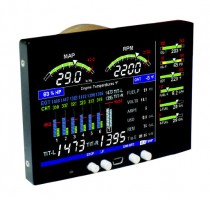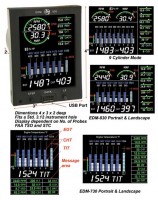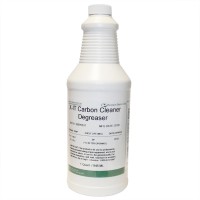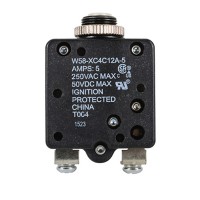JPI EDM-730 Engine Monitoring System
Overview
|
The EDM-730/830 revolutionizes engine monitoring by the integration of brilliant full color graphical LCD display with the extremely popular EDM 700/800 series functionally and yet reduces the package size to the smallest on the market! The EDM-730 packs more features, functionality, and information onto its large full color screen than any other monitor available and features larger characters for easier reading. Oil pressure has also been added to the entire EDM series line. Mounting is a breeze due to its standard 3-4/8" format, and because it can be mounted in either portrait or landscape orientation, thus accommodating virtually any panel configuration. Depth behind the panel is an amazing 2-1/2". The unit is "Plug and Play" compatible with existing EDM-700/800 units. Bayonet & Adapter: This option includes 3 bayonet probes and 1 adapter allowing existing CHT probe to gauge to receive data so both the existing CHT gauge and the EDM 730 can display the CHT info at the same time. Download dimension profile here. Full Color LCD Display:
Package Form Factor:
|
Features
- User programmable engine parameters.
- Percent Horsepower.
- Rich of peak or lean of peak operation at the tough of a button.
- RPM and manifold pressure with full graphical depiction.
- Full function fuel flow computer system.
- Links to GPS for enhanced fuel management.
- Full EDM scanner functionality.
- Unit easily set to display in either portrait or landscape mode
- Monitors: 4/6/7/8/9 cylinder engines, Turbocharged engines, RPM, MP, %HP, IAT, CDT, OAT, CAT, OIL P, OIL T, CHT, EGT, VOLTS, EGT, DIF, CLD, F FLOW, F USED, F REQD, F ENDUR, F REM
Functions
Included Functions- EGT 4 or 6 Probes
- CHT 4 or 6 Probes
- Volts
- Shock Cooling
- Span (highest to lowest EGT)
- LOP/ROP JPI Exclusive Leaning Mode
- Power Connector
- EGT/CHT Harness
- EZTrends
- Data recording - 100 hrs Download USB 1 GB Memory Stick
- Selectable Positions for Linear gauges
- 3 year warranty
- Fuel Flow
- Oil Temperature
- Oil Pressure
- OAT
- TIT
- CDT
- IAT
- CARB Temperature
- RPM
- MAP
- % HP
Videos
Reviews
JPI EDM 730 6C W/FF 231 W/ 1 CHT ADAPTER PROBE
JPI EDM 730 6C W/FF 231 W/ 1 CHT ADAPTER PROBE
Too soon to see just how it works. However, the FBO had no problem installing it.
JPI EDM 730 4C W/FF 201 CHT BAYONET PROBES
excellent
Perfect for my aircraft.
Great instrument. High quality probes and wiring. Immediately observed my #3 cylinder was running high CHT. I would have never known that since my old single point CHT/EGT was on #4. Performance and price point puts this instrument on my Required Equipment List.
Heres my assessment of this unit after having it installed during overhaul of my engine. 1) Be aware that the engineering advancement effort on this product was clearly focused on the screen compared to the 700/800 series. Improvements are limited to those that could be relatively passive in an upgrade from those earlier models. For example, real estate around the screen is such that a separate toggle switch for All, Fuel and EGT/CHT is really not needed. It should have been baked into the unit. On the 800/700 it was understandable as real estate on the unit was limited. 2) The documentation is rather shameful. It shipped with a 5 year old manual that is multiple versions behind the software onboard. When I asked if I had the current manual, Support replied that it was the current document. This part of the response was a bit amusing: EDM updates occur faster than manual updates. Clearly, by about 5 years. Youll find menu options not in the manual, reworded or out of order from the book that makes it confusing to program. For example, I asked what KFactor2 was as it was not in the manual or the FAQ on the website. I was told it was for pressurized carbs and to ignore it. Great, but I asked if the manual or FAQ could be updated. The response was he did not know when the doc would be updated. So much for trying to save the next pilot a little trouble. During my inquiry I also recd a document with an attempt at outlining the current menu options. The document was scribbled on, had grammar issues and wasnt something I would allow, as a director of support at my own company, to go out the door. 3) Email support was rather poor. A lot of one line answers that were incomplete. For example, I asked how Fuel Flow impacted %HP calc as that was the only thing I had not finalized. The response led me to believe this person doesnt know: Fuel flow does play a part in %hp uncertain as to how much it would be off but should be relatively close. I offered an enhancement request for a future software version and it was glossed over and not responded to. Overall, I will say I do like the unit. The display is very nice and the information will be helpful in my operation of the aircraft. Just expect documentation and email support to be lacking/no frills and for the product itself to be optimized for a better display and upgrading older units.
Im still in the learning curve with the JPI. My major issue so far is the hard to learn interface. Its actually a fairly complicated and capable instrument, with a lot of features that I wanted, but their engineers must have decided to save money by only including 2 buttons and leaving out menus for most things. Depending on the recent context, the mode ( automatic - automatic what??? vs. manual - manual what???) of the device, how long you push the buttons (tap vs. hold vs hold for 5 seconds) and whether you push just one or both buttons at the same time for various time intervals with no visual clues for what you are doing from rote memory, it will display enough features to fill up a 68 page manual. Lord help me if my engine is going sour in the clag and I actually have to use this POS to figure out what I can do to save my family members life. Its not just the confusing interface - the manual itself is unbelievably hard to understand and it uses terms that are not defined until pages later. It has been written by someone who knows how it works and therefore assumes that everyone else must knows how it works. I fired a couple of flight instructors like that before I found a good one. Let me be a little blunt. This is a complex, arcane device with nice features and the manual is totally useless. Arrogant. We already have your money. Hope you can figure it out... I also have a couple of watches like that. Every time daylight savings time changes I have to go to the internet and read their manuals again. Maybe its me... Nah. Its not me. Anyway, as a new user with it, I am not impressed at all with its ease of use. Maybe with a few more flights ill have a different opinion. I made my own laminated cheat sheet to keep in the plane. Its hard to understand too.
Q&A
Please note, Aircraft Spruce's personnel are not certified aircraft mechanics and can only provide general support and ideas, which should not be relied upon or implemented in lieu of consulting an A&P or other qualified technician. Aircraft Spruce assumes no responsibility or liability for any issue or problem which may arise from any repair, modification or other work done from this knowledge base. Any product eligibility information provided here is based on general application guides and we recommend always referring to your specific aircraft parts manual, the parts manufacturer or consulting with a qualified mechanic.
The JPI EDM 730/830 is 3.1"W x 4.2"H x 3.0"D without connectors and wire. Also note that this gauge (3-1/8” mounting hole) can be mounted up, down, right and left. For more information please see our videos tab.
The JPI EDM 830 comes with this in the box or you can order the options for fuel flow, RPM and MAP found on the accessories tab.
You can purchase a JPI 730 first and later add any/all the engine features of the JPI 830.
Yes, the JPI EDM 730 and 830 are FAA certified (TSO'd) engine monitors. Please note they are secondary monitors (meaning you will have to keep your existing engine gauges and probes).
Yes, based on which version you select (4 or 6 cylinders) you will get that many probes for EGT and CHT. You will also get fuel flow if you select the option.
Percent horsepower is one of the options included with the EDM730.
JPI recommends using CHT sender part number 10-03689 to be used in conjunction with your existing senders. You can mount EGT probes next to existing probes with no problems.
The file is saved as a FAT 32 4GB memory stick. It can be saved as a CSV file after loading to the computer.
Per JPI. We can replace your display if it is bad. Yes, you can upgrade to an EDM-730 without needing to re-do wires and connectors. The upgrade is plug and play.
The fs450 transducer will work with the 730. If placing an order for a 730, select the fuel flow option without transducer.






















































